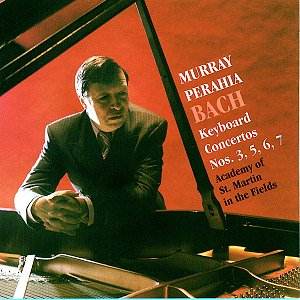The
question of which solo instrument to use for playing these concerti,
which was debated with such ferocious intensity during the first
half of the 20th Century, has now been settled. Curiously, in
this age of authentic original performance practice the answer
is: play it on anything you can put your hands on. But in those
days, I accosted Lukas Foss, whose excellent LP recording of BWV
1052 on the piano had just been released, in the hallway at UCLA
and bluntly demanded to know why he didn’t play it on the harpsichord.
He looked at me kindly and said, "because the piano is my
instrument." Of course Landowska would have retorted "but
it wasn’t HIS instrument!" and squared off for a fist fight.
But I was being fractious and Foss was right and we are much the
richer today for the variety of performances of all Bach concertos
in the authentic Baroque pluralistic attitude: whatever flies,
fly it.
And
these concerti in particular make this point for Bach produced
at least two versions of all of them. BWV 1054 is better known
as the Violin Concerto #2 in E, BWV 1042; it was the first Bach
I ever loved, having heard it played on television by Yehudi Menuhin.
I knew nothing about classical music then, and didn’t hear the
announcement; it took me four years to track down a recording
in a university library, rush home and play it over and over all
evening long. Yet I had never cared for the keyboard version which
seemed ill suited to the music. Until now, that is.
Perahia’s
version is the first keyboard version that completely satisfies.
No surprise when the keyboard artist is one of the two or three
greatest living pianists, an artist who it seems can play music
from every age as well or better than any ‘specialist,’ who always
has something vitally important to add to the dialogue about any
work he touches. Interestingly, Perahia does own a harpsichord
and plays harpsichord music on it to understand how it would sound.
Then he finds an equivalent approach at the keyboard of ‘his instrument.’
Keyboard
Concerto #5, BWV 1056, is a transcription of a presumed lost concerto
for oboe d’amour, or for violin, and the slow movement was used
in Cantata BWV 156. Some scholars believe that the slow movement
usually played here actually belongs to the Concerto #8, BWV 1059,
and utilise other music in the violin or oboe version. The Glenn
Gould recording of this work caused a sensation when it was released
and is still to be considered one of his finest performances.
But by emphasising the percussive aspects of the music, it clearly
forms one extreme, with much area remaining for alternative versions.
Perahia’s version is more lyrical, but with no less rhythmic integrity.
One
might think that for a work that the composer produced in harpsichord
and violin versions, the guitar transcription would be the perfect
choice for a solo instrument, and so it may well yet turn out
to be. But Sharon Isbin adopts for BWV 1041 a choppy technique
of absurdly accented phrases, with more antic accents than even
Glenn Gould could imagine. When this is compared directly to Perahia’s
liquid legato in these same passages, there is no contest, the
Perahia performance is at once to be preferred. He is actually
able to preserve the singing legato of the violin while keeping
the rhythmic interest of the harpsichord.
Throughout
these recordings Perahia plays lyrically and dramatically, with
great fidelity to the published score, only very rarely adding
an extra trill, passing tone, or arpeggio, and no octave doubling
that I can hear. He achieves astonishing clarity in rapid legato
passages, each note distinct, yet never slipping into that strutting,
hopping staccato of Glenn Gould at his worst, and without ever
producing the smeary burbling tone of, for instance, Pletnev playing
Scarlatti. The Kipnis recordings were a revelation when first
released on LP, the first versions by top drawer artists of some
of these lesser known concertos; but in comparison with recent
recordings they now seem somewhat low key, lacking in drive and
drama.
It
is in the final work where the glory of SACD sound shows itself.
In the Brandenburg Concerto #4 where the violin plays what is
here the keyboard part, there is plenty of differentiation in
the sound of the three solo instruments, likewise in the harpsichord
version. But the piano is so similar in sound to the flutes, playing
in the same register with a similar texture, that the SACD sound
is very helpful in clearly keeping the voices separate in our
perception, both sonically and directionally. I would expect that
in the CD version (I’ve not heard it) there is a tendency for
the instruments to merge into a single sonority.
Paul
Shoemaker


![]() Murray Perahia, Steinway
piano #539525, and conducting the
Murray Perahia, Steinway
piano #539525, and conducting the ![]() SUPER AUDIO CD (PLAYABLE
ONLY ON SACD PLAYERS)
SUPER AUDIO CD (PLAYABLE
ONLY ON SACD PLAYERS)